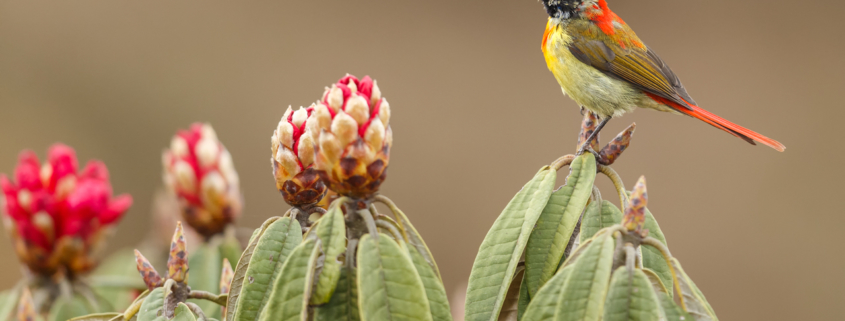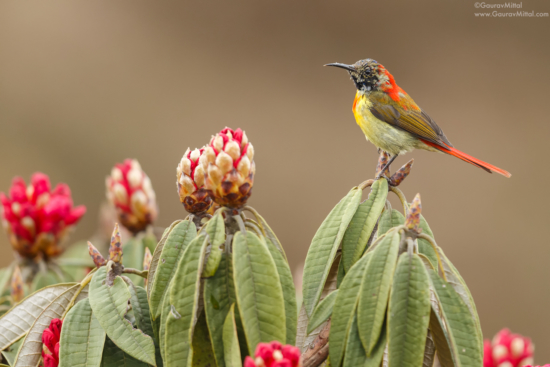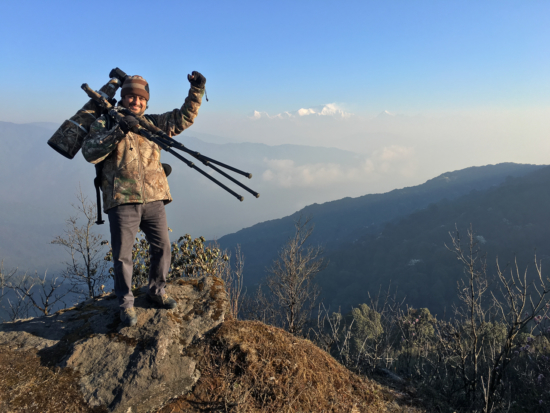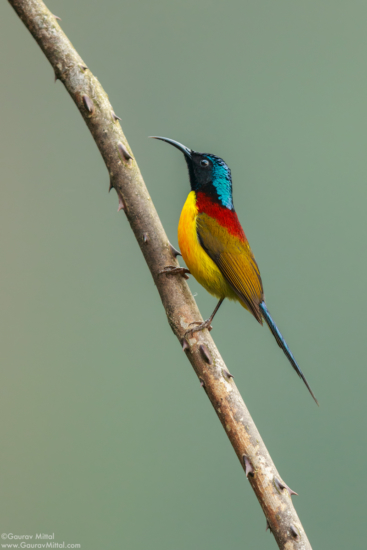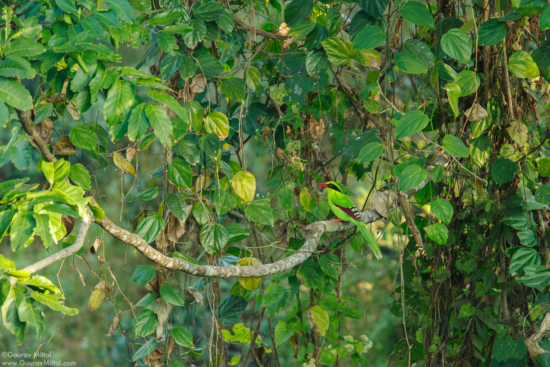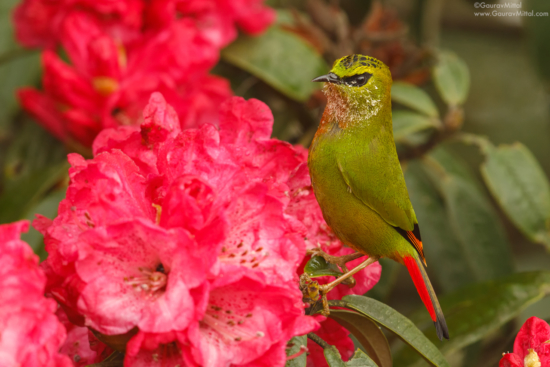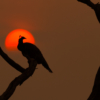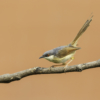Bird Photography Tips For Photographing at High Altitudes
I have made two trips to Northeast Bengal to scout the best possible locations for future bird photography tours with my good friend Debapratim Saha (a zoologist and an expert bird photographer residing in the state of West Bengal). He has a vast knowledge and experience with the birds of this region. Our target high altitude locations (10,000 feet above sea level) included Mahananda Wildlife Sanctuary, Neora Valley National Park, and Singalila National Park. These parks are located in the Darjeeling district of West Bengal and are some of the richest biological zones in India with a rich variety of mammals, birds, and reptiles. March through May is the best time of year photographing birds in their rich plumage at such high altitudes.
So exactly what challenges do you run into while photographing birds at altitudes of around 10,000 feet above sea level? While the environmental conditions are different from sea level, there is quite a bit of overlap between photographing birds at sea level and photographing them at high altitudes. Here are some insights that will help bird photographers come away with some stunning photos at high altitudes.
Research for High Altitude Bird Photography
Researching your subject and location is the first step to achieving success in bird photography. Before you take on long trips into exotic locations for photographing birds, make sure that you understand the environment, the terrain and your subjects. The first thing that comes to mind when you think of high altitude areas is mountains, unpredictable weather, lack of oxygen, and difficult and steep terrains.
After research and the information provided to me by my friend, I learned that we would be weathering some challenging and unpredictable weather and that I needed to come prepared accordingly. The night before departure, my checklist was complete: hiking shoes that could withstand tough climbs and provide me with stability, gloves, head cover, thermals, jackets, pants that would keep me warm, and rain/snow protection covers for my photography equipment. Last but not least, a first aid kit for any emergencies. Being prepared ahead of time helps you remain secure and focused on photographing birds.
If you have the luxury of spending more time in a location like this it is a good idea to acclimate for a couple of days at such high altitude. This helps your body adapt to the low oxygen environment. Carrying light weight gear will help you navigate the difficult and steep mountainous terrain. Although telephoto lenses used for bird photography lenses may make this effort futile.
Camera Equipment and Accessories
What kind of camera, lens, and tripod you use directly impacts your success and the quality of bird photos that you can capture. When shooting in mountain forests, the light is often dull and can change from minute to minute. In these low light conditions you’ll often find yourself using high ISO setting up to get faster shutter speeds. I suggest that you pick a camera body that has very low noise at high ISO to capture high quality bird photos. At high altitudes, you will likely be shooting very small and skittish birds at a distance. A telephoto lens with fixed focal length between 500mm or 600mm lens is ideal for photographing birds under such conditions. These telephoto lenses provide the reach that is needed to capture the bird and their wide aperture makes them highly effective in low light conditions. These fixed focal length telephoto lenses are also very sharp compared to their zoom counter parts.
If you are on a budget you would want to consider looking at a good quality zoom telephoto lens between 100mm to 600mm focal length. Don’t forget to keep a 1.4X and 2.0X extender handy; you’ll often find yourself needing the extra reach for bird photography at such high altitude. It is extremely important to have a light carbon fiber tripod with a gimbal head so you can mount the camera and telephoto lens on it. Photographing birds in low light while hand holding your camera gear is nearly impossible. Moreover, carbon fiber tripods will lower the weight of your great and make it easier to navigate the difficult mountain terrain.
Having a hide and wearing dull-colored clothing is very helpful when shooting mountain birds as their extreme skittishness makes them very hard to get close to. Remaining obscure and hidden at a safe distance increases your odds of not being spotted and not disturbing the birds’ natural behaviors.
Photography Equipment Challenges
When photographing birds at higher elevations in mountain forests and in very cold conditions, keep in mind that your camera batteries can lose power very fast. I recommend keeping spare batteries in your warm jacket pockets and switching them out as needed. Sometimes camera batteries will regain power if kept in a warm place. It is my experience that mirrorless cameras will need more spare batteries then a DSLR camera because they use more power during their normal operation.
Condensing moisture is also an issue you will have to watch when photographing birds in mountains. When you come in from a cold morning of shooting and bring your cold photography equipment into a warm room, the moisture from the warm air will condense on to the cold photography equipment. The condensation collecting inside your photography equipment can affect the electronics of your camera. It will also fog up the glass elements of your camera lenses. Leaving the photography equipment in the room eventually dries out the moisture. However, I do recommend that you remove the batteries from the camera immediately and only reinsert them once the camera is completely dry.
Bird Photography Composition
Birds in the mountain forests come out into the open for very short durations and then dive back into thick foliage. This gives a bird photographer a very short window of opportunity to capture them. And when they do perch, they may have branches of trees behind and around them. So it is difficult to come away with a desirable bird photography composition with a clean background. In such situations, think about going wide or shooting a bird perched from afar and include the bird’s natural habitat in your photography composition. Bird photos like these give good insight into how a bird lives.
Camera Setting for Photographing Birds
Make sure that your camera is set to shoot in RAW mode. Raw mode will give you maximum control over processing your images and provide the widest available color gamut. I mostly use aperture priority mode or manual exposure mode for bird photography. However, I prefer aperture priority mode for small and skittish birds found at higher altitudes as there are fewer settings to fiddle with when photographing birds. In Aperture priority mode, I can adjust my in exposure compensation quickly with a single dial.
use AI Servo or Continuous focus mode built into my Canon DSLR camera. This allows you to maintain sharp focus on moving subjects. Today’s DSLR and mirrorless cameras offer up to several auto-focus area selections. I recommend selecting the Single Point or Spot AF for locking focus when shooting perched birds. For tracking a moving bird, the AF point expansion mode (selecting several autofocus points in a cluster) may prove effective to keep the moving subject in sharp focus.
Always shoot at the lowest possible ISO setting to keep the noise level down. I often start at ISO setting of 400 to 800 and increase if light gets worse.
Whether you are photographing birds, other wildlife, or landscapes, it’s dedication and focus that determines how far you’ll go in succeeding as a photographer. My goal is to consistently push myself to enhance my bird photography skills, to explore new locations, and to learn about new birds.
Always remember to respect nature and the birds that you are photographing. It is best to leave your birds alone when a situation arises that makes you feel uncertain or leads you to cause stress or harm to the birds you are photographing. Come back to it again at a later date with a fresh mind and a different approach. Good luck with your next bird photography expedition.

